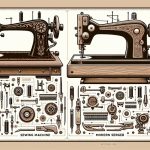Are you in the market for a new sewing machine but confused about the difference between a serger and an overlock? Don’t worry, you’re not alone. Many people struggle to understand the similarities and differences between these two machines. Fortunately, we’re here to help.
In this article, we’ll break down the similarities and differences between sergers and overlocks, as well as provide you with the pros and cons of each machine, so you can make an informed decision about which one is right for you.
First and foremost, it’s important to understand that sergers and overlocks are both types of sewing machines that are designed to finish the edges of fabric. They are often used in the garment industry to create professional-looking seams that won’t fray or unravel over time. However, while the two machines may look similar at first glance, there are some key differences that you should be aware of before making a purchase.
So, let’s dive in and explore the world of sergers and overlocks.
Table of Contents
Understanding the Similarities
Let’s take a closer look at how sergers and overlocks share some common features that make them powerful machines for creating professional-looking seams in your sewing projects.
First off, both machines are designed to trim the edges of fabric while also sewing them together. This means that you don’t have to worry about frayed edges or uneven seams when using either of these machines.
Another similarity is that both sergers and overlocks have multiple threads. This allows them to create more durable and secure seams that won’t unravel as easily. The extra threads also provide added strength to the seams, making them ideal for use in heavy-duty fabrics like denim or canvas.
Both machines are incredibly fast and efficient. They can handle large volumes of fabric in a short amount of time, making them perfect for large sewing projects or for those who need to produce a high volume of items quickly.
With either a serger or an overlock, you can complete your projects in no time and with professional-looking results.
Understanding the Differences
You can distinguish these two machines by examining their functions and features. One of the main differences between a serger and an overlock machine is their stitch types.
A serger is designed to create a chain stitch, while an overlock machine creates an overlock stitch. The chain stitch is known for its durability and flexibility, making it ideal for finishing edges that will undergo stress, such as in sportswear and knitwear. Meanwhile, the overlock stitch is perfect for creating a clean and professional-looking finish on woven fabrics.
Another difference between these machines is the number of threads they use. Sergers typically use three or four threads, while overlock machines use only two. This means that sergers can create more complex stitches and finishes, such as rolled hems and flatlocking.
On the other hand, overlock machines are much simpler to use and are perfect for beginners who want to achieve a professional-looking finish without too much complexity.
Lastly, the price point of these machines also differs. Sergers tend to be more expensive than overlock machines due to their additional features and capabilities. However, the investment may be worth it if you plan on using your machine for more advanced projects and want the flexibility to create a wide variety of stitches and finishes.
Ultimately, the choice between a serger and an overlock machine depends on your sewing needs and preferences, as both machines have their own unique advantages and disadvantages.
Pros and Cons of Sergers
When considering whether to invest in a serger, it’s important to weigh the pros and cons.
One of the biggest advantages of a serger is its speed. With multiple threads and blades, it can easily cut and finish edges in one quick pass. This makes it perfect for large projects or when you need to produce a lot of items quickly.
Another advantage of a serger is the professional finish it gives to your garments. The overcast stitch that it creates is sturdy and can withstand heavy use, making it perfect for sewing knit fabrics or for creating activewear. Additionally, sergers can create decorative stitches that can add a unique touch to your projects.
However, one of the biggest drawbacks of a serger is its complexity. It can take some time to learn how to thread it properly and to adjust the tension settings. Additionally, sergers are not as versatile as regular sewing machines and are limited to finishing edges and creating overcast stitches. They cannot replace a regular sewing machine when it comes to creating buttonholes, zippers, or other special stitches.
A serger can be a valuable addition to your sewing arsenal if you frequently work with knit fabrics or need to produce a large volume of garments quickly. However, it can also be a complicated machine to learn and may not replace the versatility of a regular sewing machine. It’s important to weigh the pros and cons before deciding to invest in a serger.
Pros and Cons of Overlocks
If you’re considering investing in an overlock machine, it’s important to weigh the advantages and disadvantages. Overlocks are similar to sergers in that they both create a finished edge on fabric, but there are some differences to consider. Here are some pros and cons of overlocks to help you make an informed decision:
Firstly, overlocks are great for speed and efficiency. They can sew up to four threads at once, which means you can finish projects much quicker than with a regular sewing machine. Additionally, overlocks are great for working with stretchy fabrics like jersey and spandex. They have the ability to stretch and move with the fabric, creating a strong and durable edge.
On the other hand, there are also some downsides to consider when it comes to overlocks. They can be difficult to use for beginners, and may require a bit of practice to get the hang of. Additionally, overlocks are not as versatile as sergers when it comes to different types of stitches. While they are great for finishing edges, they may not be able to perform other types of stitches like a serger can.
To help you compare the pros and cons of sergers and overlocks side by side, here is a table outlining the key differences between the two machines:
| Serger | Overlock | |
|---|---|---|
| Stitch types | Multiple types of stitches | Only overlock stitch |
| Versatility | Can perform a variety of stitches | Limited to finishing edges |
| Speed | Fast and efficient | Fast and efficient |
| Difficulty | May require practice to use | May require practice to use |
Ultimately, the decision between a serger and an overlock will depend on your specific needs and preferences. By weighing the pros and cons of each machine, you can make an informed decision that will help you achieve the best results for your sewing projects.
Choosing the Right Machine for Your Needs
Looking for the perfect sewing machine to fit your needs? Consider what type of projects you’ll be working on and what features are important to you.
When deciding between a serger and an overlock machine, it’s important to know the similarities and differences between the two. Here are a few things to keep in mind when choosing the right machine for your needs:
-
Think about the types of fabrics you’ll be working with. If you’ll be working with knit fabrics or stretchy materials, a serger may be the better choice. Sergers are designed to create strong, stretchy seams that can withstand the wear and tear of everyday use.
-
Consider the types of stitches you’ll need. Overlock machines are great for creating basic stitches like the 4-thread overlock, but they may not be able to handle more complex stitches like the rolled hem. If you need a wider range of stitches, a serger may be the better choice.
-
Think about the size of your projects. If you’ll be working on larger projects like quilts or curtains, you may want a machine with a larger workspace. Sergers tend to have smaller workspaces, while overlock machines are larger and can handle bigger projects.
-
Finally, consider your budget. Sergers tend to be more expensive than overlock machines, but they also offer more features and capabilities. If you’re just starting out, an overlock machine may be the better choice, but if you’re looking for a machine that can handle a wide range of projects, a serger may be worth the investment.
- Tetron Fabric for Marine Applications: Durability and Use Cases - June 18, 2025
- Tetron Fabric for Outdoor Furniture: Weather Resistance and Care - June 18, 2025
- Tetron Fabric for Wall Coverings: Style and Application Tips - June 18, 2025





